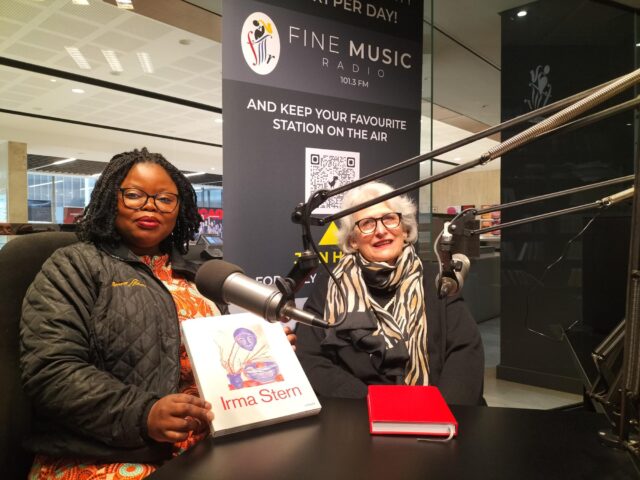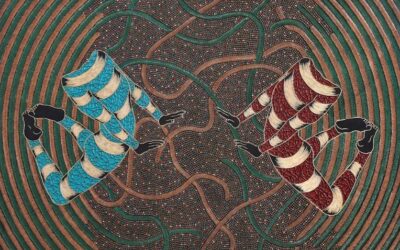Dynamic, large oil paintings in linen and smaller experimental, mixed media works on paper constitute a strong group of works by artist Zander Blom, writes Danny Shorkend.
There is an impressive sense of playful shapes at once separate from one another and yet forming a gestalt whole. There are large stretches of pure colour and yet there is often the complex flowing and intermingling of various hues. Then, perhaps most creatively, there is a reappropriation and recontextualising of Mondrian with overlaying drawings on the surface of torn books of paintings relating to that artist.
What do all these shifting forms, reflections on 20th century abstraction and collage, Matisse-like methods of paper-cole refer to? What does it mean?
The artist’s own statements appear to pit Mondrian versus Picasso. Is that the epitome of the fight between non-representational art and holding onto some, essential literal image?
A case between pure abstraction, the removal from the emotions of life toward the inner sanctuary of the studio and into the aloof world of aesthetic play/struggle and that of expressive mark-making and references to the material world in order to ignite some narrative content? The very fact that the artist has chosen to draw on Mondrian replicas from a book, a rather rebellious and cheeky move, seems to indicate that indeed the escape into pure order through colour notation, will not surmount the fact that art cannot reach its end in pure form and colour – formalism – but is concerned with creating some sort of story, of expressive and representational dimensions.
This battle, if you will between pure abstraction and literal content is difficult to resolve, for the curatorsip of the exhibition is such that columns in the gallery become ways of showing the work, wall-space an accessory to this shifting, fragmentation of form so that indeed we enter the sterile, or rather warm dance of such formal exercises. But that is not enough. Indeed, when one looks closely, pure colour has a texture.
Colour itself is often “split” into a complex web of flowing, undulating forms and space or rather the space between forms often alternate as positive shapes, as tributaries and presences in themselves, while the cut out colour-forms recede. It is clear that monism gives way to multiplicity, complexity and differentiation. In this way, there is a musical aspect to these paintings and collages and drawings, as the apparently flat works jump out at the viewer, optically pushing and pulling. The elements of art in their dynamic movement refuses to be static as the artist relates that surely one style, one formulae, one belief-system…and so on is staid and lacks precisely a certain dynamic evolvement and iteration. This would explain the artist’s impulse to avoid a singular form, preferring to split rectangular forms that suggest innumerable possible configurations with the rectangle, oval and triangle. This would also explain his cartoon-like drawings that refer to aspects of the world as well as the energetic, optical effects of his work, some conspiring to suggest monsters or figures of sorts.
In other words, the artwork does not offer a stable vantage point, nor a clearly articulated system. Space and object both form and define one another. One cannot extract a final form and an obliteration of space.
The sense of balance and weight, the relationship between scale, format and composition are both delightful for the eye and suggest order amidst chaos.
This purely abstract ideal in then contradicted by the agitated smaller drawings that seem to deny these very formal elements. The artist refuses to only learn from either the metaphysician Mondrian or the expressive Picasso – he mingles and intermingles styles and by implication, philosophical points of view. The result: The inconceivability that there is an all-encompassing and final telos toward which art must aspire. As we can safely say painting is not dead, so art offers endless creative possibilities. At the same time, we are indebted to the artistic forbears that discovered a new country, for it is surely in creative work that the world itself can be seen in new ways, not simply to resonate in terms of the beauty of its formal elements but in terms of a system of signs that yet refer, as for example social critique or philosophical reflection.
Whether Blom intends merely to titillate the eye or in his art-theoretical references, in the tension between drawing and painting, between self and the broader art-historical influence and between abstraction and figuration, to refer beyond the art context to the idea that complexity itself can be celebrated and constitute a systematic whole, is itself not patently clear.
A strong body of work and highly recommended, concludes Danny Shorkend.
WHERE: Stevenson Gallery, Buchanan Building, 160 Sir Lowry Road, Woodstock, Cape Town 7925
WHEN: to 9 April, 2016
Review by Danny Shorkend first appeared in the Cape Times






